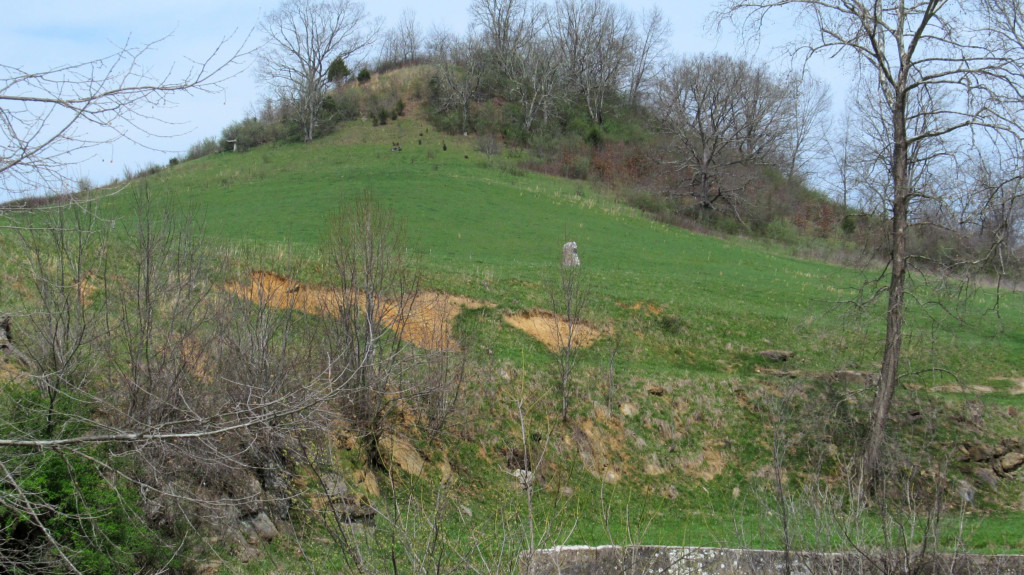In 2020 The Archaeological Conservancy, the West Virginia Land Trust, and the Greenbrier Historical Society launched a crowdfunding campaign for the acquisition of the Arbuckle’s Fort archaeological site located in Greenbrier County, West Virginia. This project was an opportunity to preserve a site dating to the Revolutionary War and early settlement period in the state, as well as protect the important natural resources located on the property which will be available for educational and tourism activities.
Arbuckle’s Fort was part of a chain of forts established to defend settlers moving into the Colonial United States’ western frontier. It was constructed in 1774 in reaction to raids from Native Americans in the western part of Virginia, now West Virginia, brought about by increasing European settlement. The fort was built above the confluence of Muddy and Mill Creeks and was first occupied by Captain Matthew Arbuckle’s militia company, who remained until the fall of 1774 when they left to guide Colonel Andrew Lewis to Point Pleasant as part of a campaign during Dunmore’s War. The fort was reoccupied at least by the fall of 1776 during the American Revolution. As groups of Native Americans increasingly sided with the British, the fort was strengthened as a defense along the Allegheny Frontier. The fort was attacked twice but held.
No description of the fort has ever been found, but excavations conducted by archaeologists Kim and Stephen McBride have helped reveal the history of this important site. Buried features include a stone chimney base and foundation from a blockhouse, with a nearby large storage pit that may have served as a powder magazine, ash and refuse filled pits, and a slag concentration from blacksmithing. A trench filled with post molds delineates a stockade with north and south bastions, and two gates. The archaeological integrity of the site; its connection to Native American, African American, and settler communities; and its rich historical documentation give the Arbuckle’s Fort site tremendous potential for research and public interpretation.
This 25-acre preserve will serve as a permanently protected monument to the struggles our Greenbrier Valley ancestors endured in the mid-1700s as they put their roots down in the region. The fort site now rests on a lush grassy knoll bordered by two slow meandering streams; inviting visitors to interpret history while peacefully enjoying the natural setting. Local school students and tourists have used the site to learn about archaeology and history; the permanent preservation of this property will ensure they can continue to do so. It is anticipated that conserving such historic sites throughout the Greenbrier Valley will increase the draw for tourists, and will ultimately boost the local economy as the Valley becomes a destination for more visitors.
About The Archaeological Conservancy
The Archaeological Conservancy, established in 1980, is the only national non-profit organization dedicated to acquiring and preserving the best of our nation’s remaining archaeological sites. Based in Albuquerque, New Mexico, the Conservancy also operates regional offices in Mississippi, Maryland, Wisconsin, and Nevada. The Conservancy has preserved over 550 sites across the nation. More information can be found at www.archaeologicalconservancy.org.
About the West Virginia Land Trust
The West Virginia Land Trust is a statewide nonprofit dedicated to protecting special places, focusing on projects that protect scenic areas, historic sites, outdoor recreation access and drinking water supplies by protecting land that borders rivers and streams. Since 1994, the organization has protected more than 10,000 acres of land statewide. More information can be found at www.wvlandtrust.org.
About the Greenbrier Historical Society
Founded in 1963, the Greenbrier Historical Society is dedicated to community enrichment through education and preservation of the history and culture of the Greenbrier Valley. A regional organization, we serve the West Virginia counties of Greenbrier, Monroe, Summers, and Pocahontas. We own and manage three properties, the North House (our offices and headquarters), the Barracks, and the Blue Sulphur Springs Pavilion. The mission of the Greenbrier Historical Society is to share the diverse history and culture of the Greenbrier Valley. More information can be found at https://www.greenbrierhistorical.org.






